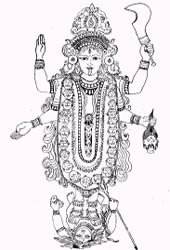
Kali
The Goddess of Yogic Transformation

-
As the chosen Deity worshipped by Paramahansa
Ramakrishna, one of the most well known modern teachers within the Hindu
tradition, Kali is one of the most commonly known of Hindu Goddesses, but
still not well understood. Yet much of what we admire in Ramakrishna
– his love, bliss, and universal spirit – is Kali’s gift to us through
him. Through him Kali has already delivered us her message for the
modern age.
-
Time is life. Life is our movement
in time. Through our own life-force or Prana we experience time.
Kali as time is Prana or the life-force. Kali or the Divine Mother
is our life. She is the secret power behind the working of our bodily
systems and vital energy. Only through her do we live, and it is
her intelligence that gives such a marvellous order to the body.
-
Kali is the love that exists at the
heart of life, which is the immortal life that endures through both life
and death. Maintaining the awareness of the eternal nature of life
through the cycles of birth and death is another one of her meditational
approaches. The truth is that our soul, our aspiration towards the
Divine, which is our eternal love, never has died and never will die.
To be conscious of that enduring aspiration is to die to the things of
the mind and the senses, and come to know the cosmic life and Divine grace.
-
Kali grants us this eternal life.
Yet the eternal life has a price. Only that which is immortal can
be immortal, as nothing can change its own nature. The mortal and
the transient must pass away. To gain the eternity that is Kali, our
mortal nature must be sacrificed. Hence Kali appears frightening
and destructive to the ordinary vision.
-
Kali as the power of death and negation
is Nirvana, the state of the dissolution of desire. She functions
to extinguish all of our wants and cravings and merge us into the Nirvanic
field, the realm of the unborn, uncreate, and unmanifest. Kali develops
forms only to take us beyond form. When her force awakens within
us she works to break down all limitations and attachments, so that we
might transcend the entire field of the known.
-
Kali is the power of action or transformation
(Kriya-shakti). Through time and breath all things are accomplished.
Yet what she accomplishes is not a mere outer action. She accomplishes
the spiritual labour of our rebirth into pure consciousness. For this
she creates the energy and does the work if we surrender to her force.
-
Kali means beauty. The root kal,
from which the name comes, means “to count,” “to measure,” or “to
set in motion,” hence “time.” It also refers to what is well-formed or
measured out, hence beauty. Time itself has a movement, a rhythm,
a dance which is the basis of all beauty. This is also the rhythm
of the life force which allows for movement.
-
Kali is dark blue in colour and wears
a garland of skulls. She has her long tongue sticking out and is
laughing. Sometimes instead of a tongue she has two fangs.
Kali has four arms and four hands and holds a head chopper with one hand
and a severed head dripping blood with the other. With
her other two hands she makes the mudras of bestowing boons and dispelling
fear. She wears a skirt made of human arms. Kali is portrayed
as dancing in a cremation ground and striding on a corpse (who is the
form of Lord Shiva himself).
